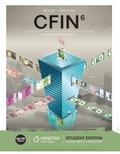
EBK CFIN
6th Edition
ISBN: 9781337671743
Author: BESLEY
Publisher: CENGAGE LEARNING - CONSIGNMENT
expand_more
expand_more
format_list_bulleted
Concept explainers
Question
Chapter 5, Problem 11PROB
Summary Introduction
Expectation theory:
Expectation theory is used to find forward interest rate based on the prevailing long term interest rates.
Calculate the forward rate as follows:
Given two year Treasury bond rate is 1.2%, three year Treasury bond rate is 1.4% and four year Treasury bond rate is 1.9%.
Expert Solution & Answer
Trending nowThis is a popular solution!

Students have asked these similar questions
4. On August 20, Mr. and Mrs. Cleaver decided to buy a property from Mr. and Mrs. Ward for
$105,000. On August 30, Mr. and Mrs. Cleaver obtained a loan commitment from OKAY
National Bank for an $84,000 conventional loan at 5 percent for 30 years. The lender informs
Mr. and Mrs. Cleaver that a $2,100 loan origination fee will be required to obtain the loan. The
loan closing is to take place September 22. In addition, escrow accounts will be required for all
prorated property taxes and hazard insurance; however, no mortgage insurance is necessary. The
buyer will also pay a full year's premium for hazard insurance to Rock of Gibraltar Insurance
Company. A breakdown of expected settlement costs, provided by OKAY National Bank when
Mr. and Mrs. Cleaver inspect the uniform settlement statement as required under RESPA on
September 21, is as follows:
I. Transactions between buyer-borrower and third parties:
a. Recording fees--mortgage
b. Real estate transfer tax
c. Recording fees/document…
Hello tutor give correct answer
Need assistance urgently by the expert.
Fake answers will be rate as unhelpful.
Knowledge Booster
Learn more about
Need a deep-dive on the concept behind this application? Look no further. Learn more about this topic, finance and related others by exploring similar questions and additional content below.Similar questions
- please don't use ai and if you cant understand given values please don't answer question otherwise unhelpful will be given.arrow_forwardfinance subjectarrow_forwardCould you help explain, what is the complete salary survey analysis, and ensuring the data is relevant and up-to-date? What is the job evaluation and compensation plan? How to ensure the final report is comprehensive, clearly structured, and aligned with the company vision?arrow_forward
- The maturity value of an $35,000 non-interest-bearing, simple discount 4%, 120-day note is:arrow_forwardCarl Sonntag wanted to compare what proceeds he would receive with a simple interest note versus a simple discount note. Both had the same terms: $18,905 at 10% for 4 years. Use ordinary interest as needed. Calculate the simple interest note proceeds. Calculate the simple discount note proceeds.arrow_forwardWhat you're solving for Solving for maturity value, discount period, bank discount, and proceeds of a note. What's given in the problem Face value: $55300 Rate of interest: 10% Length of note: 95 days Date of note: August 23rd Date note discounted: September 18th Bank discount rate:9 percentarrow_forward
arrow_back_ios
SEE MORE QUESTIONS
arrow_forward_ios
Recommended textbooks for you
 Intermediate Accounting: Reporting And AnalysisAccountingISBN:9781337788281Author:James M. Wahlen, Jefferson P. Jones, Donald PagachPublisher:Cengage Learning
Intermediate Accounting: Reporting And AnalysisAccountingISBN:9781337788281Author:James M. Wahlen, Jefferson P. Jones, Donald PagachPublisher:Cengage Learning
 EBK CONTEMPORARY FINANCIAL MANAGEMENTFinanceISBN:9781337514835Author:MOYERPublisher:CENGAGE LEARNING - CONSIGNMENT
EBK CONTEMPORARY FINANCIAL MANAGEMENTFinanceISBN:9781337514835Author:MOYERPublisher:CENGAGE LEARNING - CONSIGNMENT


Intermediate Accounting: Reporting And Analysis
Accounting
ISBN:9781337788281
Author:James M. Wahlen, Jefferson P. Jones, Donald Pagach
Publisher:Cengage Learning


EBK CONTEMPORARY FINANCIAL MANAGEMENT
Finance
ISBN:9781337514835
Author:MOYER
Publisher:CENGAGE LEARNING - CONSIGNMENT
The U.S. Treasury Markets Explained | Office Hours with Gary Gensler; Author: U.S. Securities and Exchange Commission;https://www.youtube.com/watch?v=uKXZSzY2ZbA;License: Standard Youtube License